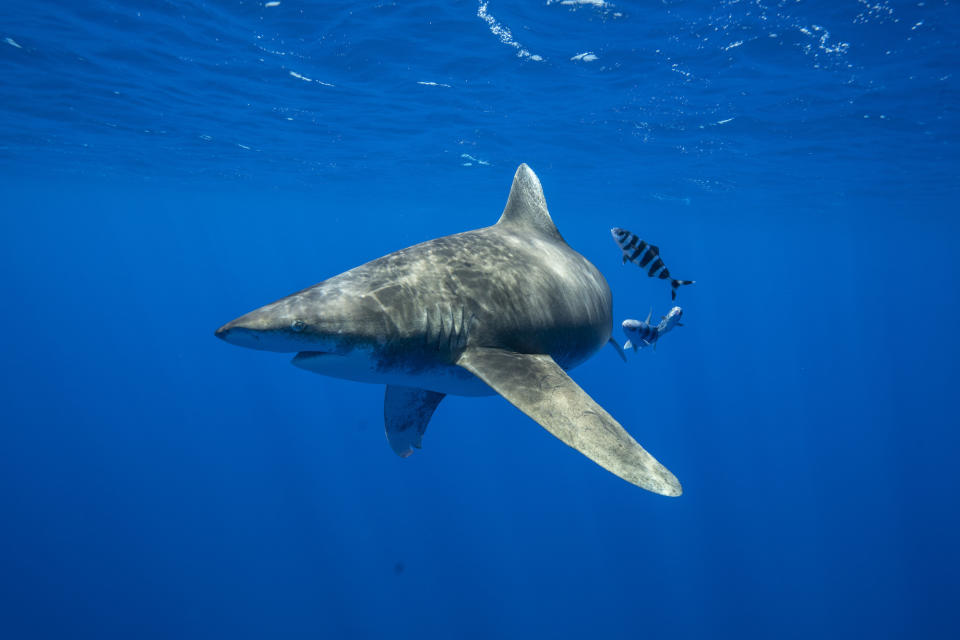Sharkfest and ‘Secrets of the Whales’: Nat Geo Is Diving Deep for Nature Programming in 2021

Even after decades of being one of the superstars of nature TV programming, sharks are beaming onto screens around the world in new ways. But not all of those changes for them and their aquatic colleagues are welcome ones.
Speaking at the CTAM Winter 2021 Press Tour, a virtual panel of National Geographic experts previewed future nature programming in the Disney family of networks, from the upcoming ninth edition of the Nat Geo network’s fan-favorite Sharkfest to the Disney+ series “Secrets of the Whales.”
More from IndieWire
The latter features the work of Brian Skerry, who has been photographing majestic underwater seascapes for decades. In his time spent beneath the waves before and during “Secrets of the Whales,” he’s noticed an increase in our understanding of the ways these massive creatures aren’t as dissimilar from humans as you might imagine.
“We’re looking at the ocean through the lens of culture,” Skerry said. “What we can see, and what science is showing us is that these animals have rich lives, much like our own. They babysit. They have food preferences, depending where in the world they live. They have singing competitions. They have parenting techniques and strategies, and they also mourn for their dead.”
That sense of connection isn’t always the same for sharks. Despite their fame in the collective cultural consciousness, they tend to take on a different role. “We love to have monsters. And that’s kind of what sharks are to us. They’re not cuddly, they’re not cute, you know, they’ve got rows of sharp teeth. So we love to fear them,” “Shark Attack Files” host Melissa Cristina Márquez said. “There’s over 500 different species. And even for those famous ones, like great whites or whale sharks, there’s really big gaps in our knowledge of them.”

Seeing those animals up close has shifted over the years. Before key advancements in technology, filming sharks was demanding in a much different way. “Now we dive with rebreathers, this technique that doesn’t release bubbles. But before when we were using typical scuba diving, we were holding our breath as much as possible not to make bubbles and not to scare the sharks. The hammerheads are are very shy,” said Enric Sala, who’ll be leading the upcoming “Pristine Seas: The Power of Protection.”
Through hunting and alterations to their habitats, shark populations are experiencing rapid, dangerous alterations in various parts of the world. After a lifetime spent observing sharks, pioneering underwater cinematographer (and contributor to the upcoming “Shark Beach”) Valerie Taylor pointed out some of those fundamental shifts. “In February last year, I was in our hotspot of Papua New Guinea. Not a shark, not one. Not even a big fish,” Taylor said. “You could go in the water off the coast of Australia, snorkeling, and see a shark. I haven’t seen a dangerous shark, or potentially dangerous shark, while snorkeling for years.”
As with seemingly all stories related to nature, there’s a kind of give and take. To witness the behavior of these animals takes a certain amount of cooperation, a boatload of skill, and a respect for the subjects.
“As an underwater photographer, we don’t have the luxury that our terrestrial counterparts do. I can’t sit in a camouflage blind in some remote location and use a 600 mm lens on a tripod and wait for some elusive animal to come wandering past. We can only stay underwater as long as the air supply on our back will last,” Skerry said. “In the three years of filming ‘Secrets of the Whales,’ that’s all free diving, just snorkeling or breath-hold diving. So I’m only underwater for a couple of minutes, maybe, at best. Even in the clearest of water, you need to get within a few meters of your subject. But inevitably, throughout all those years, I’ve been amazed at how these animals are curious. They have to let me into their world in order to make these pictures in order to tell these stories.”
Best of IndieWire
'Bridgerton' Season 2: Everything You Need to Know About the Netflix Hit
'WandaVision': All of the Marvel Easter Eggs and Sitcom References So Far
Sign up for Indiewire's Newsletter. For the latest news, follow us on Facebook, Twitter, and Instagram.

